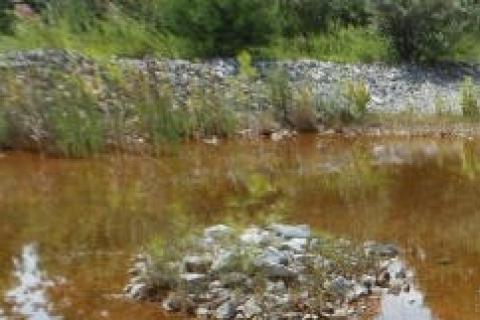
I've got several water well stories to tell, here’s a few of my favorite ...
Got a call from a man north of Dallas a few years ago. He had built a small pond in his yard. But, it was muddy all the time. I had him send a water sample. Analyzed it. Yep, it was  muddy, for no apparent reason. Looked at the cations and anions. There were more negatives than positives. I knew that couldn’t be right. After all, I had been taught nature wouldn’t allow anything other than a balance in water. As we all scratched our heads, educated minds eased our pain.
muddy, for no apparent reason. Looked at the cations and anions. There were more negatives than positives. I knew that couldn’t be right. After all, I had been taught nature wouldn’t allow anything other than a balance in water. As we all scratched our heads, educated minds eased our pain.
We learned water always seeks a balance…always. This man’s water was balanced. With dirt. Tiny suspended pieces of dirt added the missing positive charges his water desperately sought. Why?
I drove down, took a look. Sure enough, he had a well, pumping crystal clear water into his pond. Then, he had a pump hooked up to irrigate his lawn, pumping water from the pond bottom. The mystery was nearer to being solved. His well water came out of the ground pretty and clear, but was so out of balance coming out of the ground, it did what it had to do to balance itself. It was literally picking dirt off the pond bottom, and physically holding it in suspension. His water was heavy on carbonates and bi-carbonates. It needed more charged particles to seek a natural balance. The water chose dirt. Once we figured it out, we were able to buffer the stuff with gypsum. He stopped irrigating with the water when turf experts explained what this water would do to his lawn. He left the pond as a scenic landscaping spot, amended the water, planted some pretty water plants, and now enjoys it as it is.
Here’s another story. One conscientious homeowner drilled a well, and decided to aerate it by running water over a waterfall. Great idea. He built a beautiful waterfall, cascading down a pretty creek through the yard, into the pond. Well water is devoid of oxygen, and by breaking it up over big rocks, letting it fall a few feet, added oxygen. Oxygen is good. After a month, the entire waterfall and its pool was coated orange. Iron. Not such a big deal, but his Labrador retrievers couldn’t wait to immerse themselves in the pool below the falls..every day. The black labs came out looking like some sort of punk rocker with funky colored hair. Not exactly what the landowner had pictured in his mind’s eye. Toss in the fact his dogs would shake, rattle and roll themselves in the least kind places. Iron was beginning to be painted all over the place. How did he solve the dilemma? He re-routed the well water straight into the pond, and set up a pump in the pond to pick up water for the waterfall. Within a week, all the iron was gone, and he was still aerating pond water. Problem solved.
Iron. Not such a big deal, but his Labrador retrievers couldn’t wait to immerse themselves in the pool below the falls..every day. The black labs came out looking like some sort of punk rocker with funky colored hair. Not exactly what the landowner had pictured in his mind’s eye. Toss in the fact his dogs would shake, rattle and roll themselves in the least kind places. Iron was beginning to be painted all over the place. How did he solve the dilemma? He re-routed the well water straight into the pond, and set up a pump in the pond to pick up water for the waterfall. Within a week, all the iron was gone, and he was still aerating pond water. Problem solved.
Before you drill a well, do some homework. Contact reputable local drilling companies. Odds are, they have drilled a well somewhere nearby. The will have logs of the well, and can tell you quite a bit about the water, different aquifers, and quantities of water you might expect. Use the well driller as a consultant, and be confident when asking questions. You need answers.
Written by Bob Lusk, Pond Boss Editor and Fisheries Biologist
POND BOSS Magazine is the world’s leading resource for fish, pond and fisheries management information including discussions on muddy water, raising trophy fish, fish feeding, building a pond, algae control and more. Check us out at www.pondboss.com or contact Bob Lusk, the Pond Boss himself. Call FREE 903-564-5372 end_of_the_skype_highlighting.
- 6614 views

